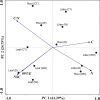Regulating carbon and water balance as a strategy to cope with warming and drought climate in Cunninghamia lanceolata in southern China
- PMID: 36466246
- PMCID: PMC9714357
- DOI: 10.3389/fpls.2022.1048930
Regulating carbon and water balance as a strategy to cope with warming and drought climate in Cunninghamia lanceolata in southern China
Abstract
Human activities have increased the possibility of simultaneous warming and drought, which will lead to different carbon (C) allocation and water use strategies in plants. However, there is no conclusive information from previous studies. To explore C and water balance strategies of plants in response to warming and drought, we designed a 4-year experiment that included control (CT), warming (W, with a 5°C increase in temperature), drought (D, with a 50% decrease in precipitation), and warming and drought conditions (WD) to investigate the non-structural carbohydrate (NSC), C and nitrogen (N) stoichiometry, and intrinsic water use efficiency (iWUE) of leaves, roots, and litter of Cunninghamia lanceolata, a major tree species in southern China. We found that W significantly increased NSC and starch in the leaves, and increased NSC and soluble sugar is one of the components of NSC in the roots. D significantly increased leaves' NSC and starch, and increased litter soluble sugar. The NSC of the WD did not change significantly, but the soluble sugar was significantly reduced. The iWUE of leaves increased under D, and surprisingly, W and D significantly increased the iWUE of litter. The iWUE was positively correlated with NSC and soluble sugar. In addition, D significantly increased N at the roots and litter, resulting in a significant decrease in the C/N ratio. The principal component analysis showed that NSC, iWUE, N, and C/N ratio can be used as identifying indicators for C. lanceolata in both warming and drought periods. This study stated that under warming or drought, C. lanceolata would decline in growth to maintain high NSC levels and reduce water loss. Leaves would store starch to improve the resiliency of the aboveground parts, and the roots would increase soluble sugar and N accumulation to conserve water and to help C sequestration in the underground part. At the same time, defoliation was potentially beneficial for maintaining C and water balance. However, when combined with warming and drought, C. lanceolata growth will be limited by C, resulting in decreased NSC. This study provides a new insight into the coping strategies of plants in adapting to warming and drought environments.
Keywords: Chinese fir; carbon and water balance; defoliation; drought; warming.
Copyright © 2022 Fang, Lin, Zhang, Lai, Chen, Xiao, Xie, Zhu, Yang and Wang.
Conflict of interest statement
The authors declare that the research was conducted in the absence of any commercial or financial relationships that could be construed as a potential conflict of interest.
Figures






Similar articles
-
Effects of Drought Stress on Non-Structural Carbohydrates in Different Organs of Cunninghamia lanceolata.Plants (Basel). 2023 Jun 28;12(13):2477. doi: 10.3390/plants12132477. Plants (Basel). 2023. PMID: 37447038 Free PMC article.
-
[Effects of arbuscular mycorrhizal fungi inoculation on non-structural carbohydrate contents and C:N:P stoichiometry of Heptacodium miconioides under drought stress].Ying Yong Sheng Tai Xue Bao. 2022 Apr;33(4):963-971. doi: 10.13287/j.1001-9332.202204.014. Ying Yong Sheng Tai Xue Bao. 2022. PMID: 35543048 Chinese.
-
[Changes of non-structural carbohydrates in Caryopteris mongolica seedlings during the process of drought-induced mortality].Ying Yong Sheng Tai Xue Bao. 2019 Aug;30(8):2541-2548. doi: 10.13287/j.1001-9332.201908.005. Ying Yong Sheng Tai Xue Bao. 2019. PMID: 31418176 Chinese.
-
Responses of leaf morphology, NSCs contents and C:N:P stoichiometry of Cunninghamia lanceolata and Schima superba to shading.BMC Plant Biol. 2020 Jul 29;20(1):354. doi: 10.1186/s12870-020-02556-4. BMC Plant Biol. 2020. PMID: 32727357 Free PMC article.
-
[Ozone Pollution, Nitrogen Addition, and Drought Stress Interact to Affect Non-structural Carbohydrates in the Leaves and Fine Roots of Poplar].Huan Jing Ke Xue. 2021 Feb 8;42(2):1004-1012. doi: 10.13227/j.hjkx.202007213. Huan Jing Ke Xue. 2021. PMID: 33742897 Chinese.
Cited by
-
Trade-Offs and Partitioning Strategy of Carbon Source-Sink During Fruit Development of Camellia oleifera.Plants (Basel). 2025 Jun 23;14(13):1920. doi: 10.3390/plants14131920. Plants (Basel). 2025. PMID: 40647931 Free PMC article.
References
-
- Adams H. D., Guardiola-Claramonte M., Barron-Gafford G. A., Villegas J. C., Breshears D. D., Zou C. B., et al. . (2009). Temperature sensitivity of drought-induced tree mortality portends increased regional die-off under global-change-type drought. Proc. Natl. Acad. Sci. U S A. 106, 7063–7066. doi: 10.1073/pnas.0901438106 - DOI - PMC - PubMed
LinkOut - more resources
Full Text Sources

